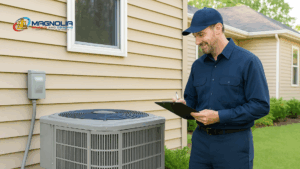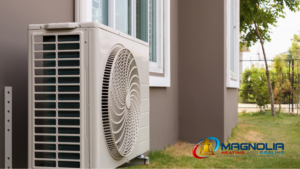
Determining the perfect thermostat temperature settings can be a fine balancing act between comfort, conservation, and cost. That’s why Magnolia Heating and Cooling, the best HVAC company around, has done the legwork finding the recommended thermostat temperature settings for both summer and winter that best suits your situation while considering the nuances between natural gas and electric heating systems!
A Seasonal Guide to Thermostat Settings
Summer Serenity
1) General Recommendations: Experts recommend setting the thermostat to 78 degrees F (26 degrees C) when at home and active. Raising it to around 85 degrees F (29 degrees C) when away can foster significant energy savings.
2) Natural Gas Cooling: Natural gas systems can heat up spaces rapidly, enabling a swift transition to comfort upon arrival. Hence, a higher setback temperature when away is advisable for optimal energy conservation.
3) Electric Cooling: Electric systems may take a tad longer to regulate temperatures. A moderate setback temperature when away can thus be beneficial to prevent extended recovery periods.
4) Night-time Niche: Slight adjustments to 1-2 degrees cooler can facilitate a tranquil slumber without hefty energy bills.
Winter Warmth
1) General Recommendations: 68 degrees F (20 degrees C) is the golden number for winter thermostat settings when the house is occupied. Lowering it by 7-10 degrees F for 8 hours daily, preferably when asleep or away, can result in appreciable savings.
2) Natural Gas Heating: Quick and efficient, natural gas systems allow for significant temperature setbacks when the house is vacant, without compromising on the time needed to regain comfort.
3) Electric Heating: For electric heating, a cautious approach to temperature setbacks is prudent. A modest reduction can prevent the system from overworking when returning to the set comfort level.
4) Layered Luxury: Embracing warm layers and cozy blankets can support a lower thermostat setting, enhancing both comfort and savings.
Adaptive Advancements: Smart Thermostats
In the era of technological triumphs, smart thermostats emerge as the heralds of heating and cooling efficiency. They adapt to your routines, make intelligent adjustments, and provide insightful energy consumption data. Investing in such a device can seamlessly align comfort with conservation, regardless of the heating system employed.
Tailoring to Types: Natural Gas vs. Electric
Understanding the distinct characteristics of natural gas and electric heating systems is pivotal in tailoring thermostat settings. Natural gas units, known for their rapid response, permit more flexible temperature adjustments. In contrast, electric systems, with their gradual temperature modulation, necessitate thoughtful setting strategies to avoid overconsumption.
Energy Efficiency and Environmental Stewardship
Harmonizing comfort with energy efficiency is not just a pathway to reduced utility bills; it is a stride towards environmental stewardship. Every degree of adjustment can make a substantial difference in energy consumption, thereby reducing the carbon footprint and contributing to a greener, more sustainable future.
Get the Most Out of Your HVAC System with Magnolia Heating and Cooling
Navigating the intricacies of thermostat temperature settings for summer and winter need not be a daunting task. By adhering to the recommended settings for summer and winter and appreciating the distinctions between natural gas and electric heating, a harmonious blend of comfort and savings is attainable. Always remember, every adjustment is a step towards a sustainable future. For expert advice and unparalleled HVAC services, don’t hesitate to reach out via phone or email to Magnolia Heating and Cooling, where your comfort is our commitment!



